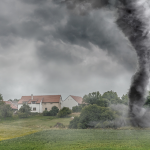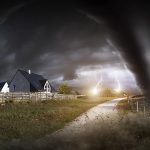The 5 Deadliest Hurricanes in US History
The deadliest hurricanes are the most infamous. Hurricanes are generally one of the costliest natural disasters regarding loss of life and financial destruction.
Thanks to modern technology, meteorologists can track and measure hurricanes long before they make landfall. The advanced warning systems in place prevent the loss of life. So, even though hurricanes and other tropical cyclones are becoming more frequent and more powerful, the loss of life due to them is becoming significantly less.
Even with advanced technology, some hurricanes sweep in with such unprecedented power, professional meteorologists can be caught off-guard.
Why Are Hurricanes Getting More Powerful but Less Deadly?
Our ability to detect and measure hurricanes has improved dramatically since the 1900s. A giant leap in weather measurement technology happened in the late 1940s. Scientists discovered that they could modify the radar systems used to detect aircraft to detect thunderstorms instead.
Before Doppler radar was adopted for meteorological use, the best method for detecting storms was through physical sightings. Ships and observatories would call in storm sightings and locations, allowing authorities to calculate trajectories. This flawed system – though good for its time – lacked accuracy. It was much more difficult to predict where these storms would go and how much damage they would inflict.
Weather systems haven’t been the only advancement since the early 1900s. The ability to create more infrastructure that can withstand a hurricane’s merciless winds has also improved.
Combined, in modern times, we have advanced warning systems that help us detect and monitor storms and better infrastructure that is less likely to collapse and cause harm during a storm. Death tolls for hurricanes and other storms have decreased in recent years.
So, although storms have become more frequent and more powerful due to the rise in global temperatures, their overall death toll has declined.
The Most Deadly Hurricanes
Even though technology has advanced to prevent mass casualties, nature still manages a few devastating blows every once in a while. So, while three of the deadliest hurricanes predate modern technology, two hurricanes in the last two decades have surpassed most other natural disasters in terms of death tolls.
- 1900 – Galveston Hurricane – Category 4 (landfall) – Max Winds 145 mph – 6,000-12,000 dead
The hurricane with the highest mortality rate in US history all but leveled the Texas coastal town of Galveston.
This storm took most of the town unawares. A mix of poor communication, crude technology, and political circumstances created the perfect storm to keep most of the population of Galveston ignorant of the approaching danger.
It was too late by the time the town residents knew of the storm.
Nearly two-thirds of the town was destroyed by the time the storm cleared out. Once a shining pearl along the Texan coast, this bustling island city had nearly wholly lost its entire infrastructure. The storm surge of about 15 feet quickly overtook the island, with an average elevation of five feet above sea level.
The storm continued its rampage across the mainland for several days before making its way north and east out into the Atlantic ocean, where it eventually petered out.
In all, most of the death and destruction occurred around the town of Galveston. When adjusted for inflation and other economic factors, the financial cost of this storm is still one of the greatest in US history.
- 2017 – Hurricane Maria – Category 4 (landfall) – Max Winds 175 mph – 3,059+ dead
One of the deadliest Hurricanes is also one of the most recent ones. Hurricane Maria hit the island of Puerto Rico directly, completely covering this landmass of over 3,500 square miles.
Even with advanced notice of the hurricane and its power, there was little time or ability to evacuate. Before the storm hit the coast, the eye of the storm expanded, nearly tripling in size, exposing a larger area to the ruthless winds of the storm wall.
Many people couldn’t evacuate due to flooding and winds. Rainfall, storm surge, high winds, and other factors destroyed buildings and trapped tens of thousands.
Though not the deadliest disaster in US history, Maria is a reminder that storms are still lethal.
- 1928 – Okeechobee Hurricane – Category 5 (landfall) – Max Winds 160 mph – 2,500+ dead
The Okeechobee Hurricane caused damage all through the Caribbean and southern Florida. Most of the damage and death occurred in south Florida. The snaking path of this storm took it over several landmasses before eventually hitting the Florida coast as a weakened Category 4 hurricane.
High winds from the storm’s center forced water out of the south end of Lake Okeechobee, killing thousands. This unprecedented disaster mostly killed farmworkers in the lands south of the lake, decimating fields and cities alike.
- 1893 – Cheniere Caminada Hurricane – Category 4 (landfall) – Max Winds 130 mph –2,000+ Dead
There is very little known about the origins of this storm. This is mostly due to the lack of technology available to track and monitor storms at the time. The hurricane hit the Louisiana coast, killing around 2,000 individuals with its storm surge.
The storm weakened as it traveled overland and eventually died out as it progressed into the Atlantic.
- 2007 – Hurricane Katrina – Category 3 (landfall) – Max Winds 175 mph – 1,800 + dead
The events surrounding Hurricane Katrina differ slightly from other storms. Katrina had already hit the mainland before its deadly turn towards New Orleans. Over the hot waters in the Gulf of Mexico, Katrina went from a category 3 storm to a category 5 storm in just 9 hours.
After news of this reached local authorities and new trajectories determined Louisiana was the storm’s next target, cities in southern Louisiana issued mandatory evacuations. Unfortunately, many people remained trapped in the city of New Orleans. Flooding from the storm surge and failed infrastructure killed many people.
Reliable Evaluation With Hudson Douglass Public Adjusters
Even if the storm that hit you wasn’t one of the deadliest in US history, just a little bit of water and wind damage can cause you a lot of financial stress.
In the wake of a disaster, working with insurance companies is difficult. We make it easy to know how much your insurance company should pay you by private inspections and consulting your insurance policy.
Contact us to see how we can help you get through your disasters.




